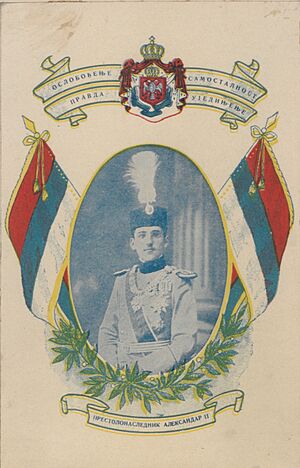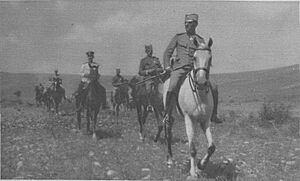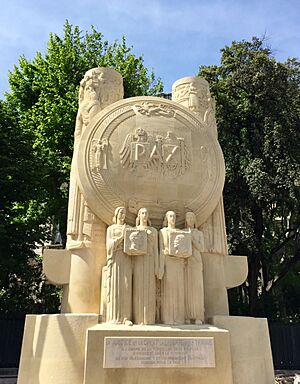Alexander I of Yugoslavia facts for kids
Quick facts for kids Alexander IAleksandar I Karađorđević Александар I Карађорђевић |
|||||
|---|---|---|---|---|---|
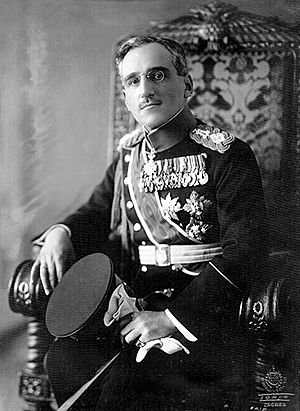 |
|||||
| King of Yugoslavia | |||||
| Reign | 16 August 1921 – 9 October 1934 | ||||
| Predecessor | Peter I | ||||
| Successor | Peter II | ||||
| Prince Regent of Serbia and the Kingdom of Serbs, Croats and Slovenes | |||||
| Tenure | 24 June 1914 – 16 August 1921 | ||||
| Monarch | Peter I | ||||
| Born | 16 December 1888 [O.S. 4 December] Cetinje Royal Palace, Cetinje, Montenegro |
||||
| Died | 9 October 1934 (aged 45) Marseille, France |
||||
| Burial | Oplenac, Topola, Serbia | ||||
| Spouse |
Maria of Romania
(m. 1922) |
||||
| Issue |
|
||||
|
|||||
| House | Karađorđević | ||||
| Father | Peter I of Serbia | ||||
| Mother | Ljubica of Montenegro | ||||
| Religion | Serbian Orthodox | ||||
| Signature |  |
||||
| Military career | |||||
| Allegiance | |||||
| Years of service | 1904–21 (end of active service) |
||||
| Rank | Field Marshal | ||||
| Unit | Royal Yugoslav Army | ||||
Alexander I (Serbo-Croatian: Aleksandar I Karađorđević / Александар I Карађорђевић, pronounced [aleksǎːndar př̩ʋiː karad͡ʑǒːrd͡ʑeʋit͡ɕ]; 16 December 1888 – 9 October 1934) was also known as Alexander the Unifier. He was the King of the Serbs, Croats, and Slovenes from 1921 to 1929. Later, he became the King of Yugoslavia from 1929 until he was assassinated in 1934. His 13-year rule was the longest of the three kings of the Kingdom of Yugoslavia.
Alexander was born in Cetinje, Montenegro. He was the second son of Peter and Zorka Karađorđević. His family, the Karađorđević dynasty, had been removed from power in Serbia 30 years earlier. Alexander spent his early life living away from home with his father in Montenegro and Switzerland. He later moved to Russia and joined a military school. In 1903, after a coup and the murder of King Alexander I Obrenović, his father became king of Serbia. In 1909, Alexander's older brother, George, gave up his right to the throne. This made Alexander the next in line.
Alexander showed great skill as a commander during the Balkan Wars. He led the Serbian army to victory against the Ottomans and the Bulgarians. In 1914, he became the prince regent of Serbia. During World War I, he was the leader of the Royal Serbian Army.
In 1918, Alexander helped unite Serbia with former Austrian areas like Bosnia, Croatia, and Slovenia. This new country was called the Kingdom of Serbs, Croats, and Slovenes. He became king when his father died in 1921. The country then faced a long period of political problems. These problems ended with the assassination of Croat leader Stjepan Radić. In response, Alexander changed the country's rules in 1929. He closed the parliament, changed the country's name to the Kingdom of Yugoslavia, and started a royal dictatorship. The new constitution in 1931 made his personal rule official. It also confirmed Yugoslavia as a single state, which upset the non-Serb people.
Political and economic problems grew worse when the Great Depression started. This crisis badly affected the country, which was mostly rural. In foreign affairs, Alexander supported the Balkan Pact with Greece, Romania, and Turkey. He also tried to improve relations with Bulgaria.
In 1934, Alexander visited France to get support for an alliance against Hungary and Italy. While in Marseille, he was assassinated by Vlado Chernozemski. This man was a member of a pro-Bulgarian group called the Internal Macedonian Revolutionary Organization. This group was helped by the Croat Ustaše led by Ante Pavelić. The French Foreign Minister, Louis Barthou, also died in the attack. Alexander was followed by his eleven-year-old son, Peter II. His cousin, Prince Paul, ruled as regent until Peter was old enough.
Contents
Early Life and Becoming Crown Prince
Alexander Karađorđević was born on 16 December 1888 in Montenegro. He was the second son of Peter Karađorđević and Princess Zorka. His family, the Karađorđevićs, had lost power in Serbia. So, Alexander's family lived in exile across Europe.
Alexander's mother, Princess Zorka, died in 1890 when he was two years old. In 1894, his father took Alexander and his siblings to Geneva, Switzerland, for school. Later, Alexander and his older brother, George, studied at a military school in St Petersburg, Russia. Alexander was known for being hard-working and quiet. He felt grateful to Emperor Nicholas II for giving him a safe place to study.
In 1903, while Alexander was still in school, a coup happened in Serbia. King Alexander and Queen Draga were killed. This brought the Karađorđević family back to power. Alexander's father became the King of Serbia. After his 15th birthday, Alexander joined the Royal Serbian Army as a private. His father wanted him to earn any promotions he received.
A major event for Alexander happened on 27 March 1909. His older brother, Crown Prince George, gave up his right to the throne. Many people in Serbia, including important politicians and military leaders, thought George was not fit to rule. They believed Alexander would be a better king. Alexander became the next in line to the throne.
In 1910, Alexander became very ill with stomach typhus. This left him with stomach problems for the rest of his life. Before the First Balkan War in 1912, Alexander acted as a diplomat. He visited Bulgaria to meet Tsar Ferdinand for secret talks. These talks aimed to form a Balkan League to remove the Ottomans from the Balkans. In March 1912, Serbia and Bulgaria signed an alliance. Greece joined them in May 1912.
Balkan Wars and World War I
In the First Balkan War in 1912, Alexander led the First Army. He won important battles in Kumanovo and Bitola. He was very proud when he led the Serb Army into Kosovo. This area was important because Serbs had fought a famous battle there in 1389. After this war, disagreements arose among the winners over control of Macedonia. Serbia and Greece then formed an alliance against Bulgaria. In 1913, during the Second Balkan War, Alexander led the Serb Army against the Bulgarians at the Battle of Bregalnica.
After the Second Balkan War, Alexander became involved in a power struggle. He disagreed with Colonel Dragutin Dimitrijević "Apis", who was a powerful military figure. Alexander saw Dimitrijević as a threat to the king's power. In January 1914, Alexander's father, King Peter, gave royal powers to his son. On 24 June 1914, Alexander officially became the regent of Serbia.
On 24 July 1914, Alexander saw the Austrian ultimatum, which was designed to be rejected. He tried to accept as many terms as possible. However, Serbia could not accept the demand for Austrian police to operate on Serbian soil. This would have ended Serbia's independence. As expected, Austria declared war on Serbia. Alexander focused on preparing his nation's defense.
When World War I began, Alexander was the official supreme commander of the Serbian army. The army fought bravely in battles like Cer and Battle of Kolubara in 1914. They pushed back the invading Austro-Hungarian forces. The Serbian army was known for being tough and fair. However, they lacked equipment, with many soldiers having no rifles or uniforms.
In 1915, the Serbian army was attacked by German and Austro-Hungarian forces. Bulgaria also invaded from the south. The Serbs suffered heavy losses. By November 1915, they were forced to retreat through Montenegro and Albania to the Greek island of Corfu. This march was very difficult, with harsh winter weather and attacks from hostile tribes. Many Serbs died along the way. Alexander himself faced danger and his health suffered. British and French ships rescued the surviving Serbs, about 140,000 of them, and took them to Corfu.
In September 1915, the Serbian army had about 420,000 men. By the end of the year, 94,000 had been killed or wounded, and 174,000 were captured or missing. The losses among Serb civilians were also huge. A typhus epidemic also hit the country hard. Serbia had the highest percentage of population losses of any country in the war.
The surviving Serb soldiers were sent to Thessaloniki to join the Allied forces. In 1916, Alexander's conflict with the Black Hand group became serious. Colonel Dimitrijević began to criticize Alexander's leadership. Alexander suspected a threat to his power. He had Dimitrijević and other Black Hand members arrested in December 1916. They were found guilty and executed in June 1917.
At the same time, the Serbian government-in-exile discussed creating a new nation called Yugoslavia. This new country would unite all South Slav peoples. In June 1917, the Corfu Declaration was signed, promising Yugoslavia after the war. Alexander was unsure about Yugoslavia at first. He often spoke of liberating Serbia. However, as the Austrian Empire collapsed in 1918, the idea of Yugoslavia became a reality. On 1 December 1918, Alexander was asked to declare Serbia united with the former Austrian provinces. This led to the birth of the Kingdom of Serbs, Croats and Slovenes.
King of Yugoslavia
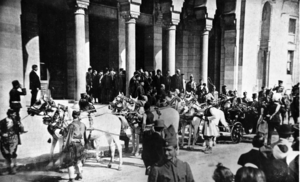
On 1 December 1918, Alexander officially became the Prince Regent of the new Kingdom of Serbs, Croats, and Slovenes. This country was often called Yugoslavia. One of his first actions was to support land reform. This meant breaking up large land estates and giving land to peasant families. This reform aimed to create more free landowners.
On 16 August 1921, Alexander became king after his father's death. He was a quiet and private man. Historians find it hard to know his exact thoughts because he didn't keep a diary or write memoirs. However, he strongly believed in keeping Yugoslavia as a single, united country. He was against the idea of federalism, which he thought would break up the country.
On 8 June 1922, King Alexander married Princess Maria of Romania. She was the daughter of King Ferdinand I of Romania. They had three sons: Crown Prince Peter, Prince Tomislav, and Prince Andrej. This royal wedding helped strengthen the alliance with Romania. It also showed that the Karađorđević family was now accepted by other European royal families.
In foreign policy, Alexander wanted to keep the peace system created after World War I. In 1921, Yugoslavia joined the Little Entente with Czechoslovakia and Romania. This alliance was formed to protect against Hungary, which had claims on their territories.

A main challenge for Yugoslavia in the 1920s was Fascist Italy. Italy wanted to take parts of Slovenia and Croatia. Because of this fear, Alexander signed an alliance with France in 1927. France became Yugoslavia's main ally. Alexander I and Benito Mussolini, the leader of Italy, were strong rivals.
Starting in 1926, some political parties in Yugoslavia, including the Croat Peasant Party, tried to stop the government from passing laws. They wanted Yugoslavia to become a federation, with more power for different regions. In June 1928, a frustrated politician shot the Croat leader Stjepan Radić. Radić was very popular in Croatia, and his assassination pushed Yugoslavia close to civil war. Alexander considered letting Croatia separate peacefully.
In response to this crisis, King Alexander ended the constitution on 6 January 1929. He closed the parliament and started a personal dictatorship. This was called the "January 6th Dictatorship". One of his first actions was to fire many civil servants to fight corruption. He also changed the country's name to the Kingdom of Yugoslavia. He divided the country into nine new areas called banovinas. These new borders did not follow historical regions, which caused resentment, especially in Bosnia and Croatia. Alexander tried to promote a single Yugoslav identity.

The royal dictatorship made Alexander unpopular, even in Serbia. In Croatia, it was seen as Serbian control. This led to more support for the Ustashe, a group that wanted Croatian independence through violence. By 1931, the Ustashe were carrying out attacks and assassinations. This made Alexander more cautious and less likely to meet ordinary people.
The Great Depression hit Yugoslavia hard. It caused prices for farm products to drop, hurting many rural families. In 1931, Alexander created a new Constitution. This gave the King executive power. Elections were held, but the King appointed half of the upper house. This constitution kept Yugoslavia as a single state, which angered non-Serbian people who wanted a federation.
In 1932, Alexander helped farmers by stopping debt payments for six months. He also prevented banks from taking over farms. These actions saved many peasants from ruin. However, they also made banks unwilling to lend money to farmers, which slowed down modernization in agriculture.
In September 1932, Alexander's friend, the Croat politician Ante Trumbić, suggested that Croats might be better off if they separated from Yugoslavia. This was a painful blow for Alexander. Other groups also started demanding a new constitution that would make Yugoslavia a federation. This multi-ethnic opposition forced Alexander to ease his strict rule.

By 1933, Alexander became worried about Nazi Germany. France, Yugoslavia's ally, also urged him to make Yugoslavia more stable by adopting federalism. Alexander also feared that Germany might expand and become a direct neighbor. He supported keeping Austria independent. He also cautiously supported plans to include the Soviet Union in an alliance against Germany. In 1933–34, Alexander pushed for a Balkan Pact. This pact would unite Yugoslavia, Greece, Romania, and Turkey. He hoped this alliance would offer some protection against Germany and Italy.
Assassination
In 1934, French Foreign Minister Louis Barthou tried to build an alliance against Germany. This alliance would include France's allies like Yugoslavia, along with Italy and the Soviet Union. However, the rivalry between Benito Mussolini (Italy's leader) and King Alexander made this difficult. Alexander complained about Italy's claims on Yugoslavia and its support for the Croat Ustaše.
Barthou invited Alexander to France to sign an agreement. This agreement would help Barthou convince Mussolini to drop his claims against Yugoslavia. On Tuesday, 9 October 1934, Alexander arrived in Marseille, France, for a state visit. He wanted to strengthen the alliance between France and Yugoslavia.
As Alexander was slowly driven through the streets with French Foreign Minister Barthou, a Bulgarian gunman named Vlado Chernozemski shot the King and the driver. Alexander died in the car. Barthou was also killed by a stray bullet fired by French police during the chaos. Four people in the crowd were also fatally wounded.
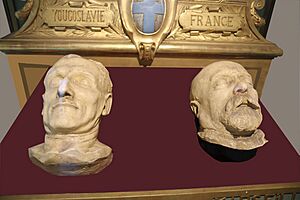
The assassin was a member of the Internal Macedonian Revolutionary Organization (IMRO). This group wanted Macedonia to be independent. IMRO worked with the Croatian Ustaše group, led by Ante Pavelić. People in Yugoslavia believed Italy played a key role in planning the assassination. French police found that the assassins were trained and armed in Hungary. They had traveled to France with fake passports and were in contact with Pavelić, who lived in Italy.
However, France and Britain did not want to blame Mussolini. They saw him as an important European leader. When Yugoslavia asked Italy to hand over Pavelić, France was worried he might reveal Mussolini's involvement. They were relieved when Italy refused to extradite Pavelić.
The day after the assassination, King Alexander I's body was taken back to Split in Yugoslavia. A large funeral was held in Belgrade, attended by about 500,000 people and many European leaders. Alexander was buried in the Oplenac Church in Topola, which his father had built. Since his son, King Peter II, was still a child, Alexander's cousin, Prince Paul, became the regent of the Kingdom of Yugoslavia.
After the assassination, relations between Yugoslavia and France became cooler. The alliances Alexander had built, like the Little Entente and the Balkan Pact, lost their importance.
Issue
| Name | Birth | Death | Spouse | Children |
|---|---|---|---|---|
| King Peter II | 6 September 1923 | 3 November 1970 | Princess Alexandra of Greece and Denmark | Crown Prince Alexander (b. 1945) |
| Prince Tomislav | 19 January 1928 | 12 July 2000 | Princess Margarita of Baden Divorced 1981 |
Prince Nikola (b. 1958) Princess Katarina (b. 1959) |
| Linda Mary Bonney | Prince George (b. 1984) Prince Michael (b. 1985) |
|||
| Prince Andrew | 28 June 1929 | 7 May 1990 | Princess Christina Margarethe of Hesse Divorced 1962 |
Princess Maria Tatiana (b. 1957) Prince Christopher (1960–1994) |
| Princess Kira Melita of Leiningen Divorced 1972 |
Princess Lavinia Maria (b. 1961) Prince Karl Vladimir (b. 1964) Prince Dimitri (b. 1965) |
|||
| Eva Maria Andjelkovich |
Honours
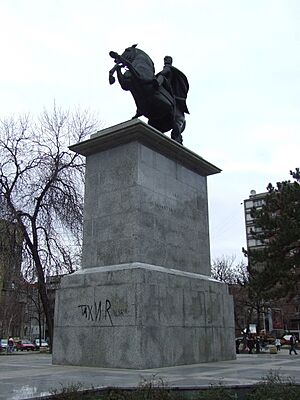

Alexander I received many important awards and honors from Serbia, Yugoslavia, and other countries around the world. These included military decorations and orders of knighthood.
Images for kids
-
Regent Alexander at the opening ceremony of the first Ljubljana Fair at Slovenia in 1920.
-
King Alexander I in the uniform of Admiral of the Navy on Adriatic 1930, oil on canvas, work of Ivan Vavpotič, National Museum of Slovenia.
-
1919 Autochrome by Auguste Léon
See also
 In Spanish: Alejandro I de Yugoslavia para niños
In Spanish: Alejandro I de Yugoslavia para niños


